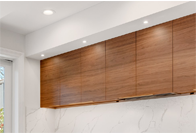Understanding Bulb Bases : Choosing the Right Fit for Your Lighting

• E12 (Candelabra Base): A smaller sibling to the E26, this base adds elegance to chandeliers and ornamental fixtures.
• GU10 (Bipin Base): The go-to for halogen and LED spotlights, it boasts two pins for that secure connection.
• T5 (Miniature Bi-Pin Base): The compact and efficient choice for fluorescent tubes.
• Fixture Compatibility: Don't play guessing games. Always check the fixture's requirements.
• Bulb Type: The battle of incandescent vs. LED vs. CFL - each might have their base preferences.
• Safety First: The base must handle the bulb's wattage. Incorrect matches might overheat and become safety risks.

In the world of lighting design, color temperature and CRI often work in tandem to achieve the desired effects. A well-designed lighting scheme strikes a balance between these two factors to create spaces that are both visually appealing and functional.
For instance, a high-end fashion boutique might blend warm lighting with a high CRI to ensure the clothing's colors appear rich and true, while also providing an inviting atmosphere. Similarly, in a modern office, a cooler color temperature combined with a decent CRI can help foster productivity and concentration among employees.
Often, it's a no-go. Physical incompatibility can lead to issues. Stick to the recommended base.
Any adapters out there for bulb bases?
They exist, but caution is key. If in doubt, ring up a lighting professional.
It might seem like a minute detail, but the right bulb base is the unsung hero that ensures your spaces are well-lit and safe. Listen to your fixture, consider your needs, and when in doubt, always reach out for expert advice.
Now, armed with this newfound knowledge, go forth and light up your spaces like a pro! And if you ever need advice or the perfect bulb, you know where to find us.








